Small Cell Networks Market Size
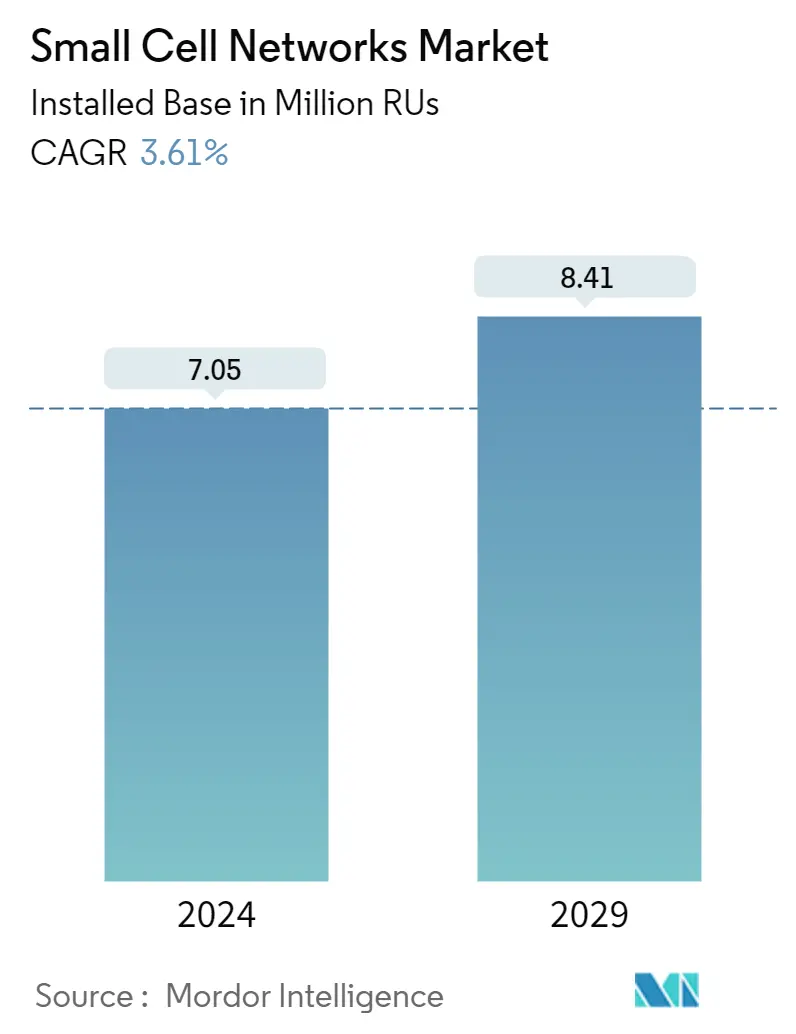
| Study Period | 2019 - 2029 |
| Base Year For Estimation | 2023 |
| CAGR (2024 - 2029) | 3.61 % |
| Fastest Growing Market | Asia-Pacific |
| Largest Market | North America |
| Market Concentration | Low |
Major Players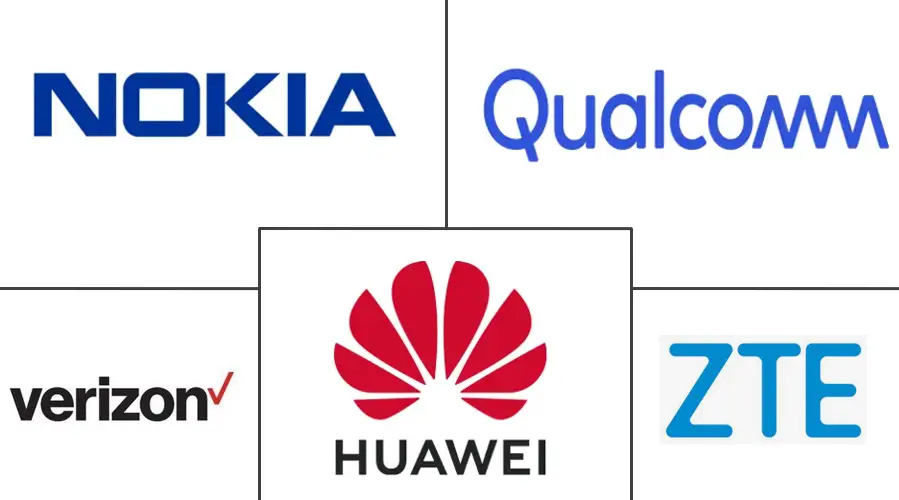
*Disclaimer: Major Players sorted in no particular order |
Small Cell Networks Market Analysis
The Small Cell Networks Market size in terms of installed base is expected to grow from 7.05 Million RUs in 2024 to 8.41 Million RUs by 2029, at a CAGR of 3.61% during the forecast period (2024-2029).
The deployment of the next-generation radio access network has expanded due to consumers' suddenly rising need for fast mobile data connectivity. Small cell network installation is expanding across commercial, residential, and industrial applications to offer better coverage at a lower cost.
- Rising mobile data traffic has caused telecom companies to move toward network densification to provide mass consumers with high-speed capacity. Due to the rise of smart cities, especially in developed economies like the U.S., Canada, Singapore, the UK, Germany, Italy, and France, more small cell 5G networks are being set up for residential, commercial, government, and industrial use.
- Further, the rapidly growing smart home and connected IoT devices shape the need for the internet differently. Several smart home features, like controlling the water supply, keeping an eye on the electricity, and having voice-activated security systems, are just the beginning of what connected devices can do. For a seamless experience, these devices need to be connected to the internet all the time and at a high speed.
- Statistics on user behavior have indicated that indoor user connections increasingly use traditional short-range unlicensed spectrum technologies, like Wi-Fi. Such devices are mainly applied to indoor scenarios, which makes them beneficial for starting the convergence spectrum. Thus, spectrum convergence through a small cell network allows for network planning and utilizing the unlicensed spectrum range more efficiently. Moreover, manufacturers of small cells are observing an increased implementation among in-building applications. For example, Ericsson collaborated with China Unicom to deploy the Radio Dot System at over 500 commercial and residential buildings in Beijing.
- Several significant countries are investing heavily in the deployment of virtualized small cell 5G network infrastructure by major telecom providers. For instance, Mavenir announced the introduction of high-capacity 5G small cell in-building independent coverage for businesses and public areas in September 2022. The 5G small cell's versatility allows for both distributed and centralized end-to-end open radio access network (ORAN) architectures.The company's ORAN technology provides end customers in manufacturing, retail, public spaces, and warehouses with a high-capacity, simple-to-deploy, and affordable solution.
- The world is still recovering from COVID-19 and has extensive internet usage, indicating the need for a whole new scale of data transfer rates. Recent adaptations of telemedicine, online education, and teleconferencing for work-from-home concepts must be fixed due to a lack of internet infrastructure. According to ASSIA, Inc., due to the COVID-19 pandemic, there was an 80% increase in PC and smartphone upload traffic since the beginning of March in the United States, with webcams, laptops, and PCs running video streams all the time.
Small Cell Networks Market Trends
This section covers the major market trends shaping the Small Cell Networks Market according to our research experts:
IT and Telecom Sectors Expected to have Significant Share in the Market Landscape.
- The increasing mobile data traffic demands advanced telecommunication networks. The deployment of 5G will facilitate the growing data usage with the required efficiency. The latest network development needs are expected to boost the market for small cell 5G networks over the forecast period.
- In the modern environment, the increased number of connected devices creates the need for increased bandwidth. For instance, according to Cisco Systems Inc., 500 billion devices are expected to be connected to the internet by 2030. Furthermore, 5G telecom companies are focusing on deploying small cells in low-frequency bands to provide customers with increased bandwidth services.
- Also, mobile data traffic is growing exponentially, primarily driven by data-capable devices and high-bandwidth applications (APPs). Vodafone, AT&T, Softbank, and other big operators have already leveraged their macro networks to create differentiation by implementing small-cell solutions. For instance, Verizon has deployed small cells in several U.S. cities, including New York, Chicago, Atlanta, and San Francisco.
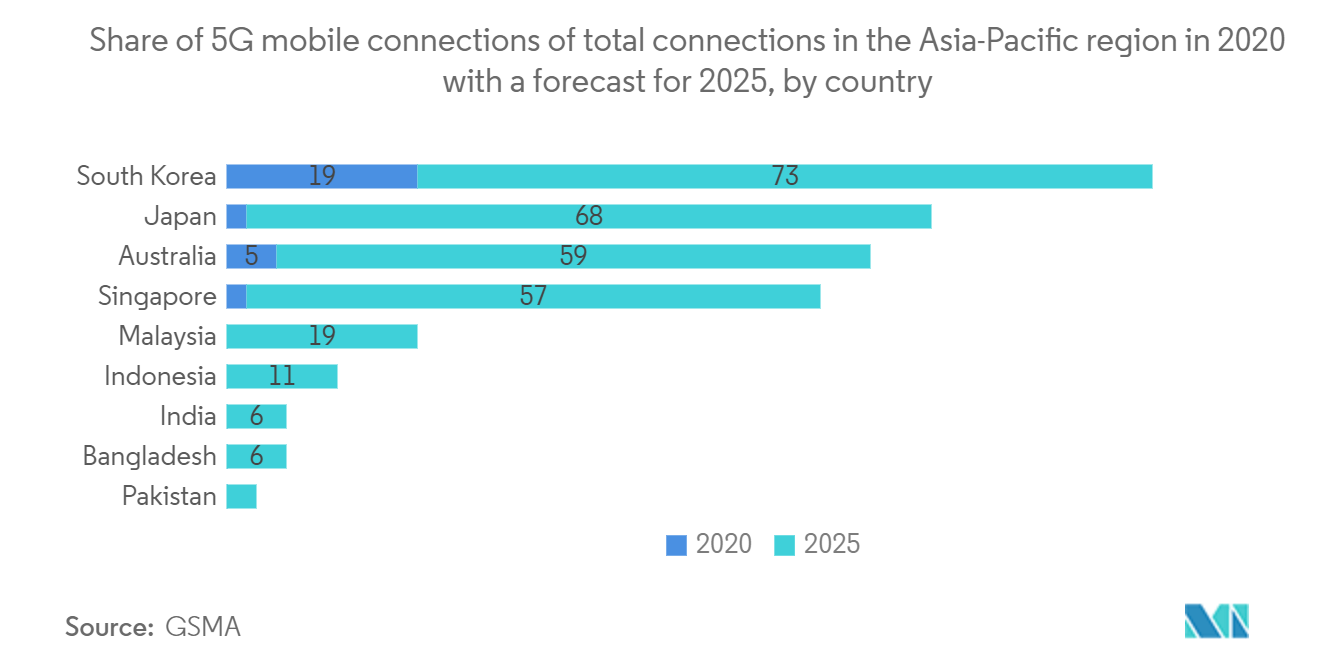
Asia-Pacific Expected to Hold the Fastest Growth Rate over the Forecast Period
- Asia-Pacific is set to depict the fastest growth rate because of the increased adoption of mobile devices and various vendor partnerships, with telecom companies introducing and strengthening 5G infrastructure. For example, in January last year, Ericsson, in association with Qualcomm and Asia Pacific Telecom (APT), completed Taiwan's first data call with 5G New Radio Dual Connectivity (NR-DC), collecting APT's spectrum holdings across mid-band (2.6 GHz) and high-band (28 GHz, or mmWave) frequencies. The trial is pivotal in Taiwan's transition to 5G standalone networks, opening several new opportunities and applications. Tests like these portray the scope for 5G small cells to be the future of the telecom industry when it comes to providing infrastructure for the same.
- Asia Pacific's constantly increasing mobile data traffic will strongly support the small cell network industry. For instance, in January last year, Datareportal reported 4.95 billion internet users worldwide. Also, as estimated by Cisco, the region is expected to have 2.6 billion internet users by the end of the year. As we correlate the facts stated by the two sources, Asia-Pacific dominates the overall share of users worldwide. Cisco also mentioned that China would lead the world in terms of the total number of home spots, followed by the US and Japan. The region's constantly increasing mobile data traffic will strongly support the small cell network industry.
- In March last year, ZTE, AIS, and Qualcomm Technologies, Inc. announced the world's first 5G NR-DC (New Radio Dual Connectivity) field demonstration, achieving a peak downlink speed of 8.5 GB/s and a peak uplink speed of 2.17 GB/s with a single mobile device in Thailand. The key band frequencies fell in the spectrum between 2.6 GHz and 26 GHz. This collaboration incorporates two critical 5G frequency bands, Sub-6 and 5G mmWave, as part of the cooperative effort to improve Thailand's 5G network's capabilities and expand the 5G application space.
- Recent developments through alliances among chief market players indicate the strong prospects of further development in the small cell and 5G telecom industries, highlighting the transition from 4G to 5G. For instance, in association with TPG Telecom, Nokia placed Asia-Pacific's first live Femtocell in a live network, keeping TPG's enterprise customers in focus. The "plug and play" nature of the Nokia Smart Node provides high quality, reliability, and low latency deliverables in terms of high-speed 4G and 5G connectivities.
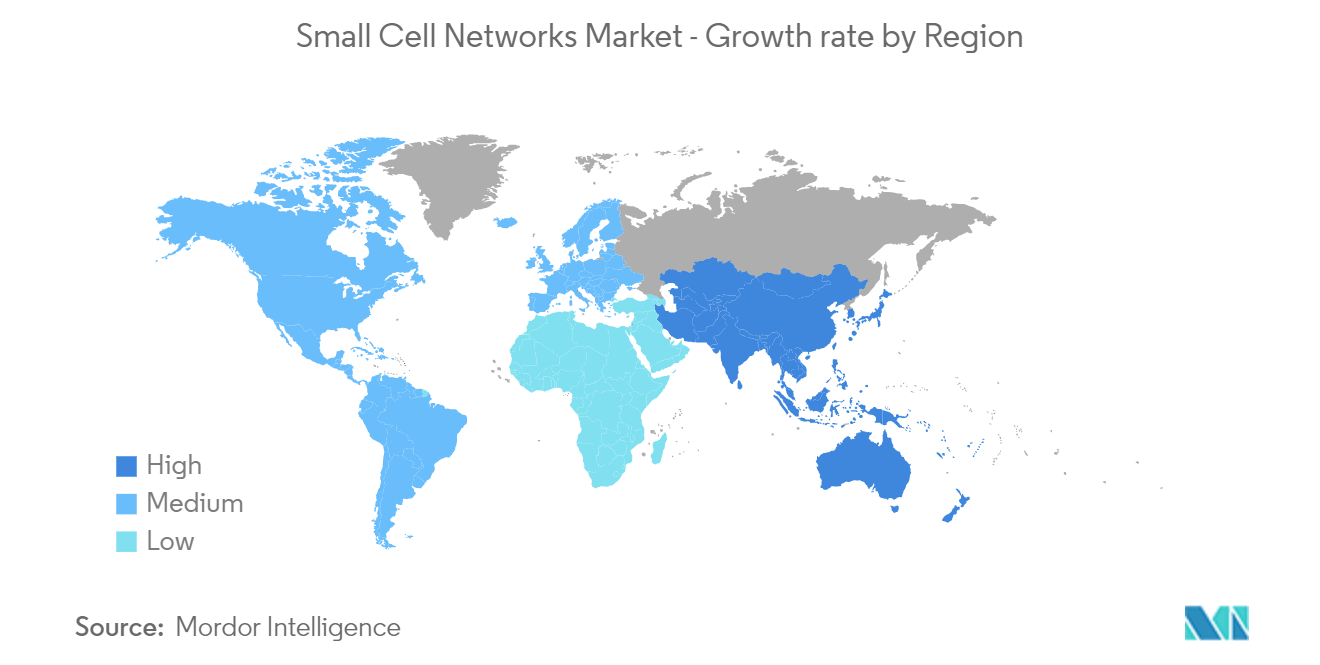
Small Cell Networks Industry Overview
The small cell network industry is fragmented because of numerous large competitors such as Nokia Networks, Qualcomm Technologies Inc., Cisco Systems Inc., and Huawei Technologies Co. Ltd. The companies are in intense competition and are constantly attempting to improve their products to acquire a competitive advantage. The corporations are also forming strategic partnerships with vendors and technology providers to expand their market share.
In March 2022, Radisys® Corporation, one of the global leaders in open telecom solutions, announced that Qucell Networks, a Korean small cell player, is deploying 5G small cell solutions for global markets leveraging Radisys' Connect RAN gNodeB software. Multiple operators' networks worldwide are testing the integrated commercial-grade 5G small-cell solution. Global partnerships among big players have contributed significantly to market disruption by sharing technologies.
In March 2022, O2 and Telefónica Germany and NEC Corporation (NEC; TSE: 6701) announced the successful launch of Germany's first open and virtual RAN architecture-based small cells. The small cell service was first deployed in Munich's city center to improve the customer experience by adding capacity to the current mobile network in this densely populated location. NEC is the primary system integrator for Telefónica S.A.'s four nations and for NEC's effort to investigate how Open RAN architecture may be deployed in various geographies (urban, suburban, and rural) for various use cases.
Small Cell Networks Market Leaders
-
Qualcomm Technologies Inc.
-
Huawei Technologies Co. Ltd.
-
Nokia Networks
-
Verizon
-
ZTE Corporation
*Disclaimer: Major Players sorted in no particular order
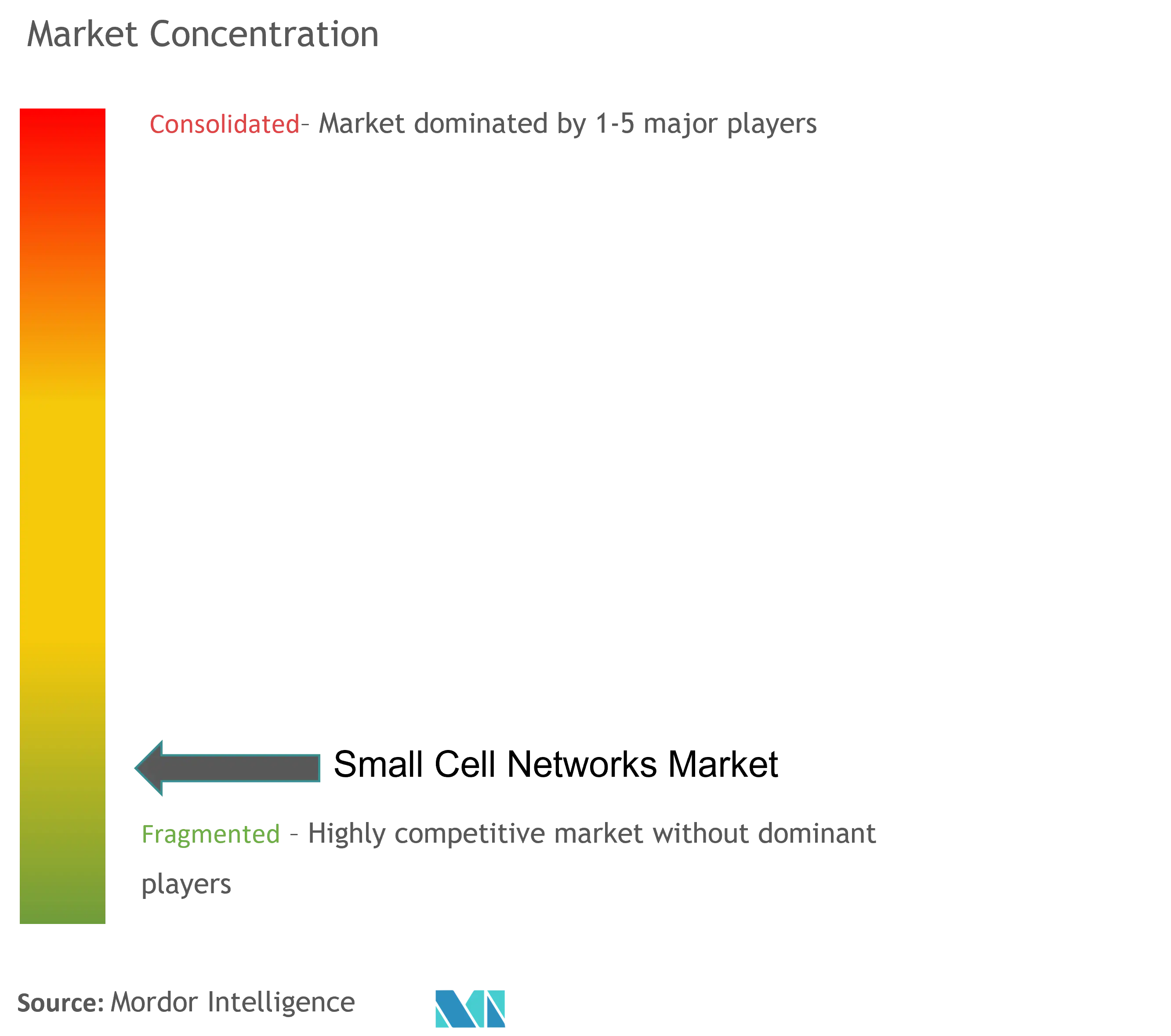
Small Cell Networks Market News
- February 2022: Qualcomm Technologies, Inc. announced the Qualcomm® Private Networks RAN Automation Platform, which makes the implementation and operation of RAN for 5G Private Networks easier. Customers in all sectors benefit from the cloud-based network management platform, which reduces system complexity, speeds up deployment, simplifies network management, and improves ease of use. The solution is built to work with core networks, small cells, and the device ecosystem powered by Qualcomm® FSMTM 5G RAN Platforms.
- October 2022: To create and develop 5G outdoor small cell solutions, Qualcomm Technologies has worked with telecom equipment manufacturer HFCL. As part of its ongoing 5G strategy, HFCL has invested in 5G outdoor small cell solutions that will speed up the rollout of 5G networks, enhance the 5G user experience, and maximize the usage of the 5G spectrum.
Small Cell Networks Market Report - Table of Contents
1. INTRODUCTION
- 1.1 Study Assumptions and Market Definition
- 1.2 Scope of the Study
2. RESEARCH METHODOLOGY
3. EXECUTIVE SUMMARY
4. MARKET DYNAMICS
- 4.1 Market Overview
- 4.2 Industry Value Chain Analysis
-
4.3 Industry Attractiveness - Porter's Five Forces Analysis
- 4.3.1 Threat of New Entrants
- 4.3.2 Bargaining Power of Buyers/Consumers
- 4.3.3 Bargaining Power of Suppliers
- 4.3.4 Threat of Substitute Products
- 4.3.5 Intensity of Competitive Rivalry
- 4.4 Impact of COVID-19 on the Market
-
4.5 Market Drivers
- 4.5.1 Evolution of Network Technology and Connectivity Devices
- 4.5.2 Rising Demand for Mobile Devices
- 4.5.3 Growth in IT and Telcom Sector to drive the overall market
-
4.6 Market Restraints
- 4.6.1 Increased Need for Managing Network
-
4.7 Technology Snapshot
- 4.7.1 Femtocell
- 4.7.2 Picocell
- 4.7.3 Microcell
- 4.7.4 Metrocell
- 4.7.5 Radio Dot Systems
5. MARKET SEGMENTATION
-
5.1 Operating Environment
- 5.1.1 Indoor
- 5.1.2 Outdoor
-
5.2 End-user Industry
- 5.2.1 BFSI
- 5.2.2 IT and Telecom
- 5.2.3 Healthcare
- 5.2.4 Retail
- 5.2.5 Power and Energy
- 5.2.6 Other End-user Verticals
-
5.3 Geography
- 5.3.1 North America
- 5.3.1.1 United States
- 5.3.1.2 Canada
- 5.3.2 Europe
- 5.3.2.1 Germany
- 5.3.2.2 UK
- 5.3.2.3 France
- 5.3.2.4 Spain
- 5.3.2.5 Rest of Europe
- 5.3.3 Asia-Pacific
- 5.3.3.1 China
- 5.3.3.2 Japan
- 5.3.3.3 India
- 5.3.3.4 Australia
- 5.3.3.5 Rest of APAC
- 5.3.4 Latin America
- 5.3.4.1 Brazil
- 5.3.4.2 Mexico
- 5.3.4.3 Argentina
- 5.3.4.4 Rest of Latin America
- 5.3.5 Middle East & Africa
- 5.3.5.1 UAE
- 5.3.5.2 Saudi Arabia
- 5.3.5.3 South Africa
- 5.3.5.4 Rest of MEA
6. COMPETITIVE LANDSCAPE
-
6.1 Company Profiles
- 6.1.1 Nokia Networks
- 6.1.2 American Tower Corporation
- 6.1.3 Qualcomm Technologies Inc.
- 6.1.4 ZTE Corporation
- 6.1.5 Huawei Technologies Co. Ltd
- 6.1.6 Verizon Wireless
- 6.1.7 Airvana Inc. (CommScope Inc.)
- 6.1.8 Cisco Systems Inc.
- 6.1.9 Qucell Inc.
- 6.1.10 Telefonaktiebolaget LM Ericsson
- 6.1.11 AT&T Inc.
- 6.1.12 Cirrus Core Networks
- 6.1.13 Airspan Networks Inc.
- *List Not Exhaustive
7. INVESTMENT ANALYSIS
8. FUTURE OF THE MARKET
** Subject To AvailablitySmall Cell Networks Industry Segmentation
Small cells are usually used in places with a lot of people, like shopping malls, city centers, sports venues, airports, train stations, housing complexes, etc., where there are a lot of people.
The Small Cell Networks Market is Segmented by Operating Environment (Indoor, Outdoor), End-user Vertical (BFSI, IT and Telecom, Healthcare, Retail, Power & Energy), and Geography (North America (United States, Canada), Europe (Germany, UK, France, Spain, and Rest of Europe), Asia Pacific (China, Japan, India, Australia, and Rest of Asia-Pacific), and Latin America (Brazil, Mexico, Argentina, and Rest of Latin America), and Middle East & Africa (UAE, Saudi Arabia, South Africa, and Rest of MEA). The market sizes and forecasts are provided in terms of value (USD million) for all the above segments.
| Operating Environment | Indoor | |
| Outdoor | ||
| End-user Industry | BFSI | |
| IT and Telecom | ||
| Healthcare | ||
| Retail | ||
| Power and Energy | ||
| Other End-user Verticals | ||
| Geography | North America | United States |
| Canada | ||
| Geography | Europe | Germany |
| UK | ||
| France | ||
| Spain | ||
| Rest of Europe | ||
| Geography | Asia-Pacific | China |
| Japan | ||
| India | ||
| Australia | ||
| Rest of APAC | ||
| Geography | Latin America | Brazil |
| Mexico | ||
| Argentina | ||
| Rest of Latin America | ||
| Geography | Middle East & Africa | UAE |
| Saudi Arabia | ||
| South Africa | ||
| Rest of MEA |
Small Cell Networks Market Research FAQs
How big is the Small Cell Networks Market?
The Small Cell Networks Market size is expected to reach 7.05 million RUs in 2024 and grow at a CAGR of 3.61% to reach 8.41 million RUs by 2029.
What is the current Small Cell Networks Market size?
In 2024, the Small Cell Networks Market size is expected to reach 7.05 million RUs.
Who are the key players in Small Cell Networks Market?
Qualcomm Technologies Inc., Huawei Technologies Co. Ltd., Nokia Networks, Verizon and ZTE Corporation are the major companies operating in the Small Cell Networks Market.
Which is the fastest growing region in Small Cell Networks Market?
Asia-Pacific is estimated to grow at the highest CAGR over the forecast period (2024-2029).
Which region has the biggest share in Small Cell Networks Market?
In 2024, the North America accounts for the largest market share in Small Cell Networks Market.
What years does this Small Cell Networks Market cover, and what was the market size in 2023?
In 2023, the Small Cell Networks Market size was estimated at 6.80 million RUs. The report covers the Small Cell Networks Market historical market size for years: 2019, 2020, 2021, 2022 and 2023. The report also forecasts the Small Cell Networks Market size for years: 2024, 2025, 2026, 2027, 2028 and 2029.
Small Cell Networks Industry Report
Statistics for the 2023 Small Cell Networks market share, size and revenue growth rate, created by Mordor Intelligence™ Industry Reports. Small Cell Networks analysis includes a market forecast outlook to 2029 and historical overview. Get a sample of this industry analysis as a free report PDF download.



